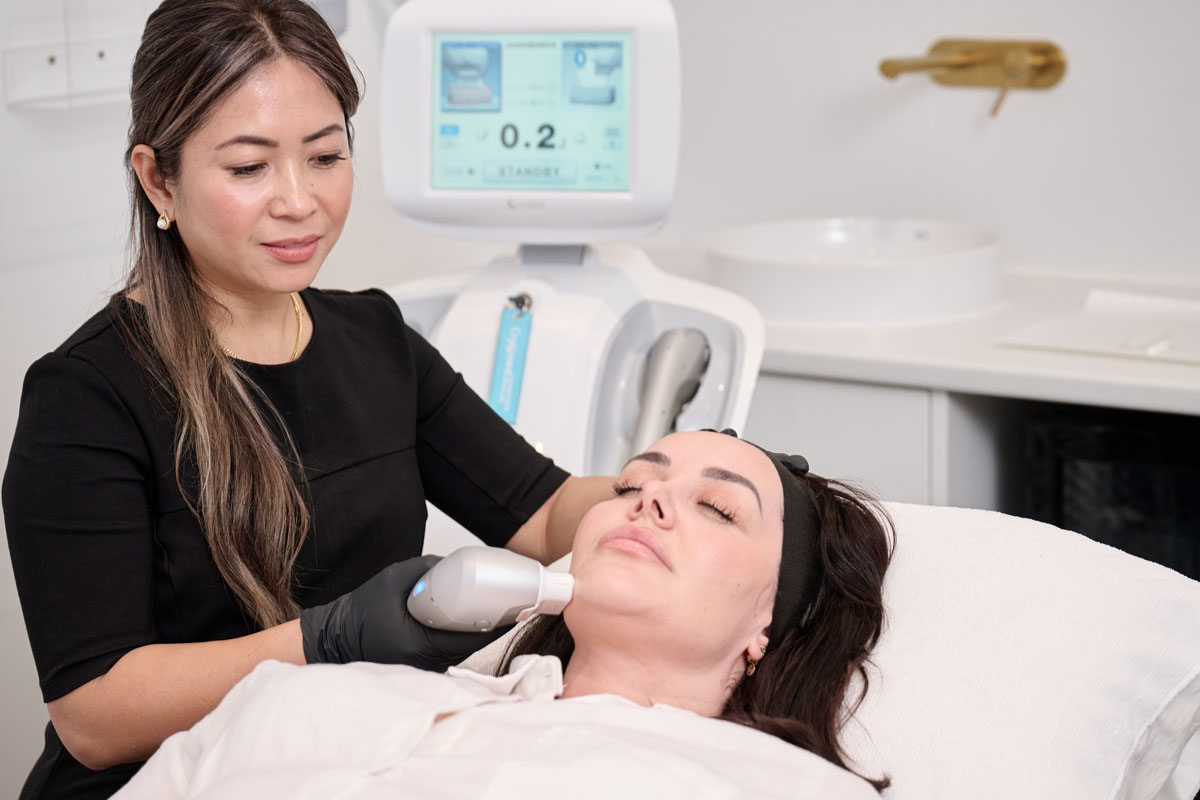Why HIFU Therapy Is the Future of Non-Surgical Facelifts
High-Intensity Focused Ultrasound (HIFU) therapy is quickly developing itself as a frontrunner in the world of non-surgical facelifts, mainly due to its capability to provide targeted skin restoration without the complexities connected with traditional procedures. By using the power of ultrasound to stimulate collagen manufacturing, HIFU provides an encouraging choice that meets the growing need for efficient, minimally invasive cosmetic services. As we check out the intricacies of HIFU modern technology and its myriad benefits, one have to think about exactly how this ingenious strategy might redefine aesthetic improvement for future generations.

Recognizing HIFU Modern Technology
High-Intensity Focused Ultrasound (HIFU) innovation has actually emerged as an innovative non-invasive treatment alternative for skin tightening up and training. This innovative method utilizes focused ultrasound waves to penetrate the layers of the skin, specifically targeting the surface musculoaponeurotic system (SMAS) and dermis. By delivering accurate power at particular depths, HIFU promotes the body's all-natural collagen production procedure, causing boosted skin flexibility and firmness with time.
The treatment is carried out using a portable device that gives off ultrasound power in a regulated fashion, guaranteeing marginal discomfort and downtime for patients (HIFU). Unlike standard medical facelifts, HIFU does not call for lacerations or anesthesia, making it a more secure option with less dangers and side results. Furthermore, the therapy is adjustable, enabling specialists to readjust criteria such as intensity and deepness according to the private patient's requirements
HIFU has actually gained popularity for its ability to give visible outcomes without the requirement for intrusive surgery. As technology remains to breakthrough, HIFU represents a significant development in aesthetic therapies, promising efficient end results while prioritizing client security and comfort. Its non-surgical nature makes it an enticing choice for those seeking a youthful look without the connected risks of typical facelift treatments.
Advantages of HIFU Therapy
As the need for non-invasive cosmetic treatments continues to rise, HIFU treatment attracts attention for its various advantages. High-Intensity Focused Ultrasound (HIFU) offers a distinct technique to skin tightening and lifting, making it an enticing choice for individuals looking for vibrant skin without the demand for surgery.
One of one of the most significant advantages of HIFU is its capacity to boost collagen production, bring about boosted skin elasticity and suppleness in time. This natural process promotes a gradual improvement in look, ensuring outcomes are both refined and enduring. Additionally, HIFU treatment is non-invasive, which suggests very little downtime and a lower danger of difficulties contrasted to traditional medical techniques.
Clients can typically resume their daily activities quickly following treatment, making HIFU a hassle-free selection for busy individuals. Furthermore, the procedure is personalized, allowing specialists to customize it to particular areas of issue, whether it be the eyebrow, jawline, or neck.
Comparison With Conventional Facelifts
When thinking about options for face renewal, several people locate themselves weighing the benefits of HIFU treatment versus standard renovations. Typical renovations involve medical procedures that rearrange underlying cells and remove excess skin, causing extra dramatic and prompt outcomes. This strategy requires significant downtime, prospective issues, and a lengthy recuperation duration.

The long life of outcomes varies; standard facelifts can last for numerous years, whereas HIFU results might need upkeep therapies every 6 to 12 months. Eventually, the choice in between HIFU and traditional renovations check hinges on individual preferences, wanted end results, and desire to undergo surgical procedures.
Ideal Candidates for HIFU
HIFU treatment click here to find out more is a superb alternative for individuals who are not all set to dedicate to invasive operations but still look for reliable face rejuvenation - HIFU. Suitable prospects commonly include those experiencing mild to moderate skin laxity and aging signs such as fine lines, wrinkles, and sagging skin, particularly in the face, neck, and décolletage areas
People in their late 30s to mid-60s often discover HIFU particularly beneficial, as this age range commonly experiences the start of skin sagging and loss of elasticity. Furthermore, those looking for a non-invasive option to medical renovations might appreciate the marginal downtime related to HIFU, making it an attractive choice for hectic professionals.
Furthermore, candidates need to be in typically excellent health and have reasonable expectations pertaining to the outcomes. It is crucial for people with particular skin problem, infections, or those that are expecting to talk to a certified specialist prior to waging HIFU treatment. HIFU. Eventually, a comprehensive assessment can help figure out if HIFU is the appropriate fit for an individual's specific skin concerns and aesthetic goals, guaranteeing ideal outcomes and satisfaction
What to Expect Throughout Therapy
Anticipation commonly goes along with the possibility of going through HIFU therapy, as people prepare to experience a non-invasive method to face rejuvenation. Upon arrival, clients will typically undertake an appointment to review their aesthetic objectives and analyze their skin disease. This individualized assessment enables the professional to customize the therapy per person's needs.
The procedure begins with the application of a gel to the targeted locations, which assists in the transmission of ultrasound power. Clients might experience a feeling of warmth or small tingling as the ultrasound waves pass through the skin layers, boosting collagen production without harming the surface area. The period of the therapy normally ranges from 30 to 90 mins, depending upon the locations being dealt with.
Post-treatment, individuals may observe small redness or swelling, which usually subsides within a couple of hours. Unlike medical alternatives, there is minimal downtime, enabling people to resume their daily tasks virtually quickly. Outcomes usually come to be more noticeable over the following weeks as collagen continues to develop, resulting in stronger, raised skin. Overall, HIFU supplies a promising option for those looking for effective facial rejuvenation without intrusive procedures.
Conclusion
To conclude, HIFU therapy represents a considerable development in non-surgical facelift choices, supplying an ingenious strategy to skin restoration that focuses on safety and effectiveness. Its capacity to promote collagen production while decreasing downtime differentiates it from typical surgical methods. As individuals significantly seek non-invasive get more choices, HIFU's customizable nature and decreased difficulty risks strengthen its placement as a leading choice in the cosmetic industry, leading the way for a future where non-surgical enhancements become the standard.